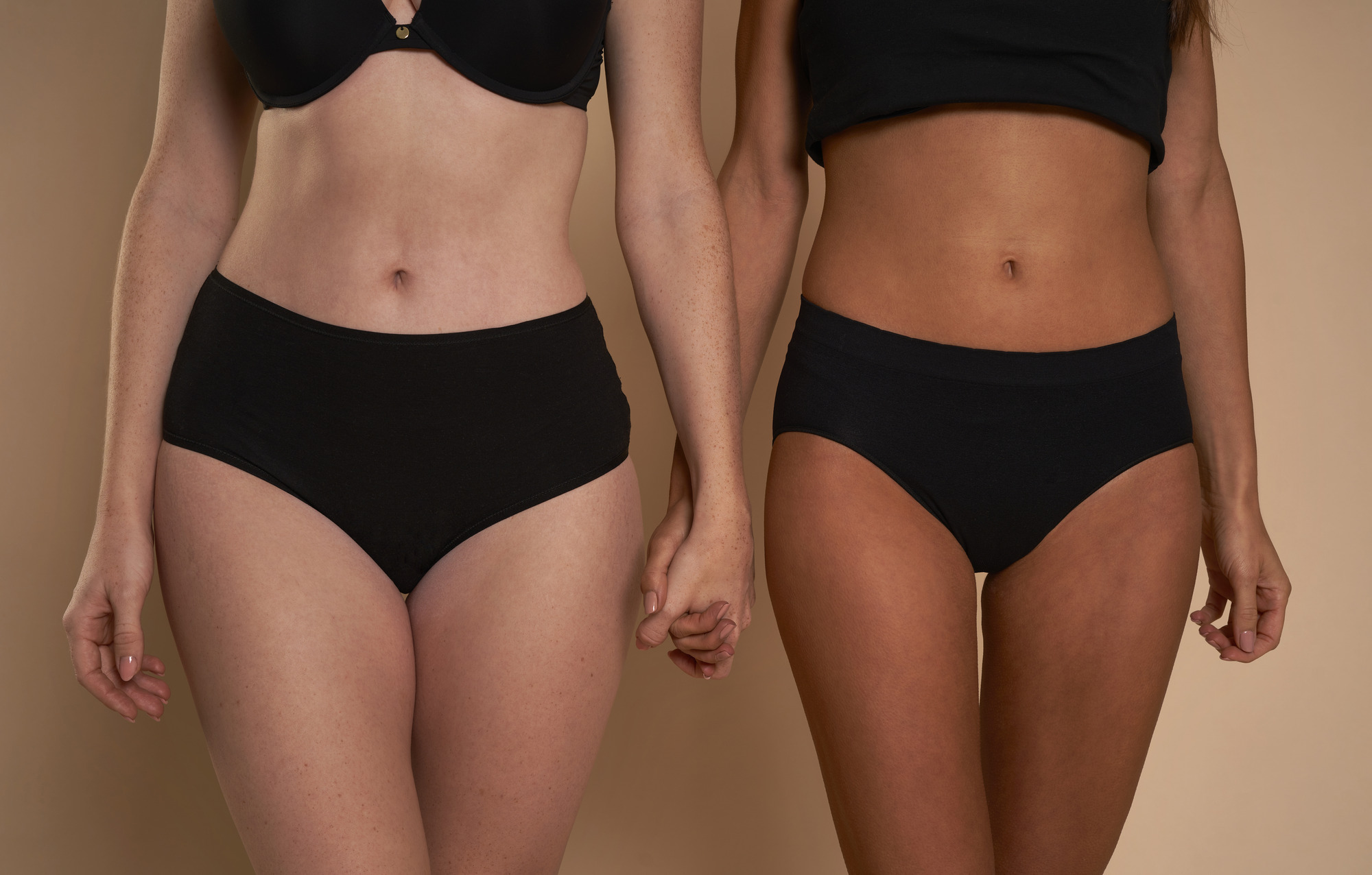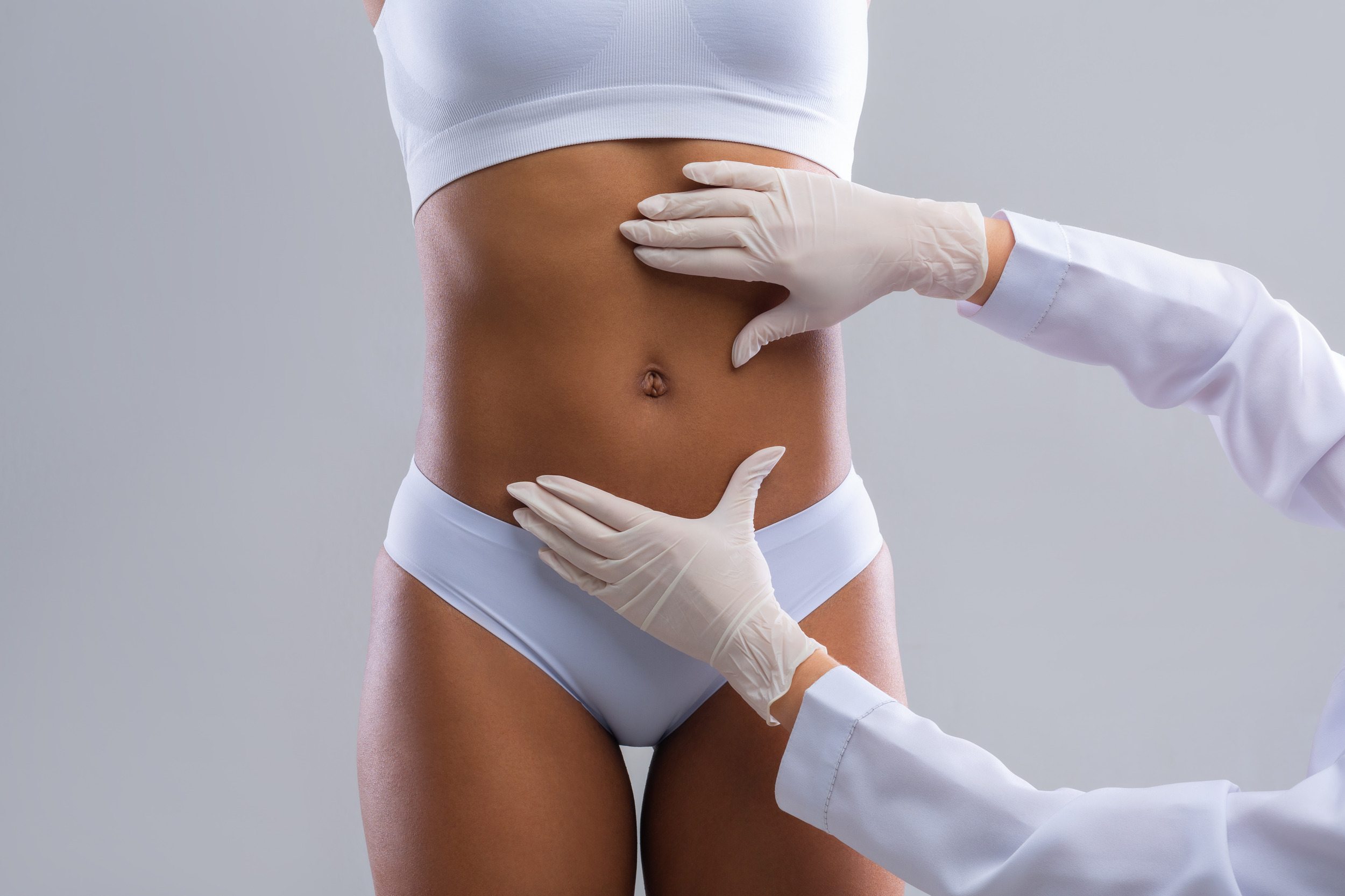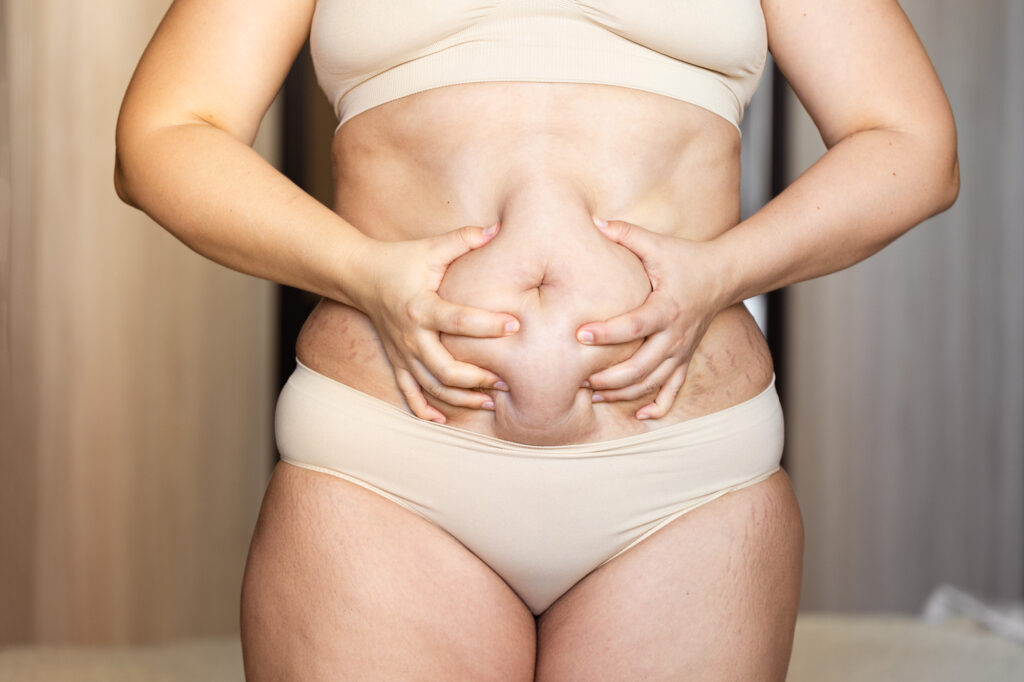The demand for body contouring procedures has increased in recent years and is expected to grow with a compound annual growth rate (CAGR) of 10.2% to reach $9.1 billion by 2026.
This increased interest is driven by the rise in:
- Obesity rates.
- Societal focus on physical appearance.
- Availability of ablative body contouring technologies such as BodyTite and tummy tuck (abdominoplasty).
Introduction to BodyTite
BodyTite was developed by InMode which is a leading medical aesthetics company. BodyTite’s RFAL technology was approved by the FDA in 2016 to provide fat removal and skin-tightening procedures to people looking for body contouring solutions. It is a body contouring technology that uses Radio-Frequency Assisted Lipolysis (RFAL) to address both unwanted fat and loose skin in an ablative.
RFAL works by delivering radiofrequency (RF) energy that liquefies fat cells and makes them easier to extract as well as stimulating the body’s collagen production within the deeper layers of the skin. Collagen is a protein that allows the skin to retract after fat removal by providing structure and elasticity.
This synergistic approach separates BodyTite from traditional liposuction methods because it allows BodyTite to offer a better solution that helps patients to expect:
- Change in your body’s circumference.
- Reduction of small areas of fat that will change your body’s silhouette.
- Firmer and more toned muscles.
- Improved appearance of cellulite.
Ideal candidates for BodyTite are adults aged 18 and older with a body mass index (BMI) under 30 and they should be physically and mentally healthy as well as have reasonable expectations about the procedure’s capabilities.
In a study by Dr. Theodorou, MD, and his team of 97 patients who underwent BodyTite procedures, the average amount of fat aspirated per treatment was 2.31 lbs, with an average of 2.52 lbs per treatment session.
Patients reported an 82% satisfaction rate for the degree of skin tightening and an 85% satisfaction rate for the body-contouring results. The overall incidence of major complications was 6.25%, and 8.3% incidence of minor complications.
Understanding the BodyTite Procedure
BodyTite® is a radiofrequency-assisted liposuction (RFAL) device used for body contouring that stands out among other procedures because it combines fat liquefaction and skin tightening. It consists of a workstation that houses a RF generator, software, and circuitry as well as specialized handpieces that connect to the workstation and are designed for specific treatment areas and procedures.
Each BodyTite handpiece has a bipolar configuration that consists of an internal electrode which is a silicone-coated cannula with a radiofrequency-emitting tip that is used for tissue manipulation and an external electrode that slides along the skin’s surface in tandem with the internal electrode.
The key aspect of BodyTite’s technology is the delivery of radiofrequency (RF) energy which oscillates between the internal and external electrodes at a rate of 1 million cycles per second. The RF energy flows from the internal electrode which is smaller and has a higher density to the large external electrode with a lower density generating heat within the treatment area. This feature allows it to have a “thermal containment” effect that minimizes heat transfer to deeper structures. According to an article by Robert Stephen Mulholland, the optimal temperature for thermal contraction and shortening of the FSN network is around 69°C.
During the procedure, the internal electrode is inserted beneath the skin. The RF energy is highly ablative and coagulative within 1-2 cm of the internal electrode but becomes more diffuse as it reaches the external electrode. Tissue close to the internal electrode experiences a necrotic, ablative thermal effect and those that are closer to the dermis experience a sub-necrotic, non-ablative thermal stimulation.
The goal of BodyTite’s RFAL technology is to achieve a three-dimensional contraction of the soft tissue which is accomplished through:
- Internal RF stimulation and contraction of the fibro septal network (FSN).
- Dermal enhancement through non-ablative thermal stimulation and neocollagenesis (new collagen formation)
Exploring Tummy Tuck Surgery

Tummy tuck surgery, or abdominoplasty was developed in the 1960s by American plastic surgeons, who refined the surgical approach to address excess abdominal skin and muscle laxity. Today, an estimated 130,000 tummy tucks are performed annually in the United States alone making it one of the most commonly performed cosmetic surgeries worldwide.
The ideal candidates for a tummy tuck are adults aged 18 and older with a body mass index (BMI) under 35 and they should be physically and mentally healthy as well as have reasonable expectations about the procedure’s capabilities.
The Tummy Tuck Process
The Tummy tuck process is performed under general anesthesia. The surgeon makes a long incision across the lower abdomen (just above the pubic area) which allows him/her to remove excess skin and fat as well as tighten the underlying abdominal muscles. In cases where the surgeon wants to address excess skin in the upper abdomen, they make another incision around the navel
Abdominoplasty is considered a major surgical procedure therefore The recovery process for an Abdominoplasty takes longer compared to ablative procedures like BodyTite and Morpheus8 because it’s considered a major surgical procedure. 80% of the patients on Realself report 2-4 weeks of downtime and 4-6 weeks before they can resume their normal daily activities.
According to the American Society of Plastic Surgeons, and data from over 5500 patients on Realself, the average cost of a tummy tuck in the United States is between $4,500 – $20,000 with an average cost of $8,000.
The tummy tuck procedure has a 95% Worth It rating on Realself, with 92% of the patients saying the procedure had a positive impact on their self-esteem and quality of life.
Comparative Analysis: BodyTite vs. Tummy Tuck

Procedure and Effectiveness
| Feature | BodyTite | Tummy Tuck (Abdominoplasty) |
| Approach | Minimally invasive. Uses radiofrequency energy (RFAL) to liquefy fat and stimulate collagen production. | Surgical procedure that involves muscle repair and skin removal. |
| Anesthesia | Local anesthesia is common but can also use general anesthesia. | General anesthesia. |
| Duration | Each treatment area takes up to 90 minutes. | Can take up to 4 hours depending on the extent of correction. |
| Effectiveness | Works best for mild to moderate skin laxity. | Is best for significant excess skin, weakened abdominal muscles, and major body sculpting. |
Recovery and Downtime
| Feature | BodyTite | Tummy Tuck (Abdominoplasty) |
| Downtime | Up to 1 week. | 2-4 weeks. |
| Discomfort | Moderate. | Moderate to severe. |
| Swelling | Mild to moderate but they subside within days. | Moderate to severe and they may take several weeks to subside. |
| Activity | It takes 4 to 6 weeks for patients to return to most daily activities | Restricted activity for several weeks |
| Compression | Patients wear a compression garment for up to 6 weeks. | Patients can wear compression garments worn for several weeks. |
Risks and Side Effects
| Risk/Side Effect | BodyTite | Tummy Tuck (Abdominoplasty) |
| Infection | Possible | Possible, with a higher risk due to larger incisions |
| Bleeding | Possible | Possible, with a higher risk due to severed vessels |
| Thermal Injury (Burns) | Uncommon, minimized by temperature control | Not applicable |
| Seroma (Fluid Buildup) | Possible | More common due to larger surgical area |
| Hematoma (Blood Collection) | Possible | More common due to severed vessels |
| Scarring | Possible, minimized by skilled technique | More likely due to larger incisions |
| Nerve Damage | Possible, but rare | Possible, can cause numbness or tingling |
| Thrombosis (Blood Clots) | Uncommon, mitigated by post-op care | More common due to general anesthesia and inactivity |
| Pulmonary Embolism | Rare, further reduced with specific anesthesia | Rare |
| Mortality Rate | Extremely low (similar to C-section) | Higher than most cosmetic surgeries (0.02% – 0.16%) |
Patient Experiences and Case Studies
A study by Theodorou, MD done in 2012 involved 97 patients who underwent RFAL targeting 144 anatomical areas under local anesthesia and found BodyTite to be safe and effective.
The results showed an overall patient satisfaction rate of 82% for skin tightening and 85% for body contouring.
In another study conducted by Theodorou and other plastic surgeons, three independent plastic surgeons were asked to evaluate the results and graded 74.5% of patients as having good to excellent results in body contour and 58.5% as having good to excellent skin tightening.
Comparing traditional liposuction (SAL) and SAL with BodyTite (RFAL) shows the combined approach results in almost double the skin surface area contraction (25.8% vs 10.4%) in one year.
Cost Considerations
| Procedure | Cost Range | Average Cost |
| BodyTite | $2,500 – $16,000 | $6,000 |
| Tummy Tuck | $4,500 – $20,000 | $8,000 |
Both BodyTite and tummy tucks are considered elective cosmetic procedures and are not covered by insurance but most facilities offer financing options or work with third-party lenders to help patients manage the costs. Be sure to inquire about available options during your consultation.
Prices vary depending on:
- The treatment area.
- The extent of the treatment area.
- The surgeon’s experience and reputation.
- The location of the facility.
- The type of anesthesia used (local or general).
Making the Right Choice
- A tummy tuck is likely more effective in a situation where there’s a lot of sagging skin and weakened abdominal muscles while BodyTite works best with less significant skin laxity and stubborn fat.
- A tummy tuck delivers a more dramatic transformation with a flatter, tighter abdominal profile while BodyTite provides patients with skin-tightening and fat reduction.
Conclusion
A tummy tuck is more effective in a situation where there’s a lot of sagging skin and weakened abdominal muscles while BodyTite works best with less significant skin laxity and stubborn fat.
A tummy tuck delivers a more dramatic transformation with a flatter, tighter abdominal profile while BodyTite provides patients with skin-tightening and fat reduction.
Recovery tolerance – BodyTite is an ablative procedure with a faster recovery.
Ensure you find a board-certified dermatologist or plastic surgeon with enough experience and a great reputation. Go through their patient reviews, research their qualifications, and ask all the necessary questions including how they approach patient safety.
FAQ Related To BodyTite vs. Tummy Tuck
Who is an ideal candidate for BodyTite, and who should consider a tummy tuck?
Ideal BodyTite candidates are adults with a BMI under 35 and have mild to moderate skin laxity and localized fat deposits. This makes it more ideal for anyone who’s looking for a minimally invasive approach with a faster recovery.
Ideal Candidates for Tummy Tuck are Adults with a BMI under 35 with significant excess skin, weakened abdominal muscles, and those with a desire for a dramatic body transformation. Be prepared for a longer recovery period.
Can BodyTite and tummy tucks be combined with other cosmetic procedures?
Yes, they can. BodyTite and tummy tucks can be combined with other body contouring or facial rejuvenation procedures like Morpheus8.
How should I prepare for a BodyTite procedure or tummy tuck?
For BodyTite, you should avoid blood-thinning medications and supplements for a week or two before the procedure. They should also maintain a healthy diet and exercise routine.
Tummy tuck patients will need to undergo a more extensive pre-operative preparation process that includes quitting smoking, adjusting certain medications, and following a diet and exercise plan. General anesthesia is required for the surgical tummy tuck procedure.
Can I undergo BodyTite or a tummy tuck after significant weight loss or pregnancy?
Yes, you can. Excess skin and stubborn fat deposits are common concerns that BodyTite or tummy tuck can address.

